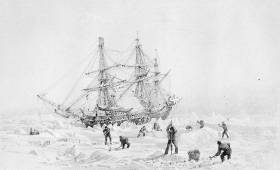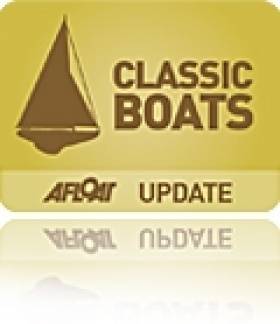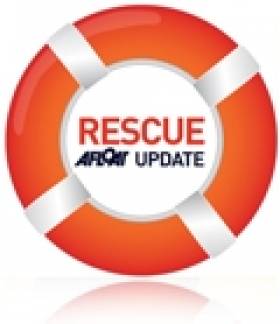Displaying items by tag: Arctic
Discovery Of Second Ship From Franklin's Lost Expedition May Rewrite History Of Northwest Passage
#HMSTerror - The discovery of what appears to be the wreck of the long-lost HMS Terror may rewrite the history of one of the biggest mysteries of polar exploration.
According to The Guardian, the nearly completely intact Vesuvius-class bomb vessel was found in a stroke of luck by researchers in an Arctic bay in the far north of Canada.
And their find was almost exactly 170 years to the day since the Terror and sister ship HMS Erebus were first trapped in polar ice northwest of King William Island in Victoria Strait.
Both vessels were part of an expedition by Sir John Franklin to complete the Northwest Passage in the 1840s, but Franklin did not live to see the final days of the ill-fated mission.
He was succeeded in June 1847 by Banbridge native Captain Francis Crozier, whose last known effort, as evident from a scrawled note from previous recovered records, was an attempt a year later to lead the remaining crew to safety along a river to the south, though no trace of their movements has been found.
However, the discovery of the Terror some 100km south of where it was previously believed crushed by the ice opens up a wealth of questions as to how Capt Crozier and his crew survived the extremes of the region for so long.
The Guardian has much more on the story HERE.
Irish Cruising Comes Centre Stage In Howth Yacht Club
With last night’s Irish Cruising Club Annual General Meeting & Prize-Giving hosted at Howth Yacht Club, and this morning’s day-long ISA Cruising Conference at the same venue, centre stage has been taken by the silent majority – the large but distinctly reticent segment of the sailing population which emphatically does not have racing as its primary interest afloat. W M Nixon takes us on a guided tour.
The great Leif Eriksson would approve of some of the more adventurous members of the Irish Cruising Club. They seem to be obsessed with sailing to Greenland and cruising along its coast. And it was the doughty Viking’s father Erik Thorvaldsson (aka Erik the Red) who first told his fellow Icelanders that he’d given the name of Greenland to the enormous island he’d discovered far to the west of Iceland. He did so because he claimed much of it was so lush and fertile, with huge potential for rural and coastal development, that no other name would do.
Leif then followed in the family tradition of going completely over the top in naming newly-discovered real estate. He went even further west and discovered a foggy cold part of the American mainland which he promptly named Vinland, as he claimed the area was just one potential classic wine chateau after another, and hadn’t he brought back the vines to prove it?
In time, Erik’s enthusiasm for Greenland was seen as an early property scam. For no sooner had the Icelanders established a little settlement there around 1000 AD than a period of Arctic cooling began to set in, and by the mid-1300s there’d been a serious deterioration of the climate. What had been a Scandinavian population of maybe five thousands at its peak faded away, and gradually the Inuit people – originally from the American mainland – moved south from their first beachheads established to the northwest around 1200 AD. They proved more successful at adapting to what had become a Little Ice Age, while no Vikings were left.
Now we’re in the era of global warming, and there’s no doubt that Greenland is more accessible. But for those of us who think that cruising should be a matter of making yourself as comfortable as possible while your boats sails briskly across the sea in a temperate climate or perhaps even warmer for preference, the notion of devoting a summer to sailing to Greenland and taking on the challenge of its rugged iron coast, with ice everywhere, still takes a bit of getting used to.
Yet in recent years the Irish boats seem to have been tripping over each other up there. And for some true aficionados, the lure of the icy regions was in place long before the effects of global warming were visibly making it more accessible.
Peter Killen of Malahide, Commodore of the Irish Cruising Club, is a flag officer who leads by example. It was all of twenty years ago that he was first in Greenland with his Sigma 36 Black Pepper, and truly there was a lot of ice about. The weather was also dreadful, while Ireland was enjoying the best summer in years.

Peter Killen’s Sigma 36 Black Pepper in local ice at the quay inside Cape Farewell in Greenland, August 1995

ICC Commodore Peter Killen’s current boat is Pure Magic, an Amel Super Maramu seen here providing the backdrop for a fine penguin in Antarctica, December 2004.
More recently, he and his crew of longterm shipmates have been covering thousands of sea miles in the Amel Super Maramu 54 Pure Magic, among other ventures having a look at lots more ice down Antarctic way to see how it compares with the Arctic. With all their wanderings, by the end of the 2014 season Pure Magic was laid up for the winter in eastern Canada in Nova Scotia. So of course in order to get back to Ireland through 2015, the only way was with a long diversion up the west coast of Greenland. And the weather was grand, while Ireland definitely wasn’t enjoying the best summer in years.
The Pure Magic team certainly believe in enjoying their cruising, however rugged the terrain. If the Greenland Tourist Board are looking for a marketing manager, they could do no better than sign up the skipper of Pure Magic for the job. His entertaining log about cruising the region – featured in the usual impressive ICC Annual edited for the fourth time by Ed Wheeler – makes West Greenland seem a fun place with heaps of hospitality and friendly folk from one end to the other.

If ice is your thing, then this is the place to be – Peter Killen’s Pure Magic off the west Greenland coast, summer 2015.
But then Peter Killen is not as other men. I don’t mean he is some sort of alien being from the planet Zog. Or at least he isn’t so far as I know. But the fact is, he just doesn’t seem to feel the cold. I sailed with him on a raw Autumn day some years ago, and while the rest of us were piling on the layers, our skipper was as happy as Larry in a short-sleeved shirt.
I’d been thinking my memory had exaggerated this immunity to cold. But there sure enough in the latest ICC Annual is a photo of the crew of Pure Magic enjoying a visit to the little Katersugaasivik Museum in Nuuk, and the bould skipper is in what could well be the same skimpy outfit he was wearing when we sailed together all those years ago. As for the rest of the group, only tough nut Hugh Barry isn’t wearing a jacket of some sort – even Aqqala the Museum curator is wearing one.
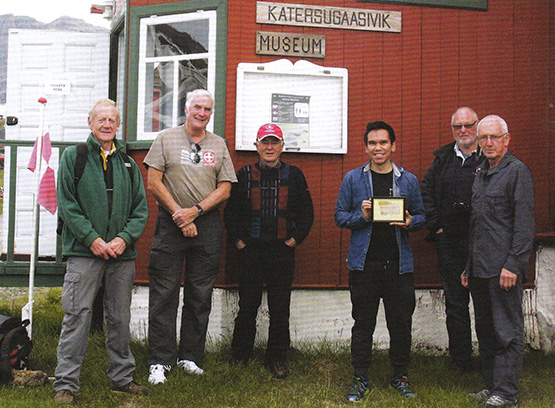
Some folk feel the cold more than others – Pure Magic’s crew absorbing local culture in Greenland are (left to right) Mike Alexander, Peter Killen, Hugh Barry, Aqqalu the museum curator, Robert Barker, and Joe Phelan
Having a skipper with this immunity to cold proved to be a Godsend before they left Greenland waters, when Pure Magic picked up a fishing net in her prop while motoring in a calm. Peter Killen has carried a wetsuit for emergencies for years, and finally it was used. He hauled it on, plunged in with breathing gear in action, and had the foul-up cleared in twenty minutes. Other skipper and Commodores please note……
The adjudicator for the 2015 logs was Hilary Keatinge, who has one of those choice-of-gender names which might confuse, so it’s good news to reveal that after 85 years, the ICC has had its first woman adjudicator. No better one for the job, man or woman. Before marrying the late Bill Keatinge, she was Hilary Roche, daughter of Terry Roche of Dun Laoghaire who cruised the entire coastline of Europe in a twenty year odyssey of successive summers, and his daughter has proven herself a formidable cruising person, a noted narrator of cruising experiences, and a successful writer of cruising guides and histories.
Nevertheless even she admitted last night that once all the material has arrived on the adjudicator’s screen, she finally appreciated the enormity of the task at hand, for the Irish Cruising Club just seems to go from strength to strength. Yet although it’s a club which limits itself to 550 members as anything beyond that would result in administrative overload and the lowering of standards, it ensures that the experience of its members benefit the entire sailing community through its regularly up-dated sailing directions for the entire coast of Ireland. And there’s overlap with the wider membership of the Cruising Association of Ireland, which will add extra talent to the expert lineup providing a host of information and guidance at today’s ISA Cruising Conference.
But that’s this morning’s work. Meanwhile last night’s dispensation of the silverware – some of which dates back to 1931 – revealed an extraordinarily active membership. And while they did have those hardy souls who ventured into icy regions, there were many others who went to places where the only ice within thousands of miles was in the nearest fridge, and instead of bare rocky mountains they cruised lush green coasts.
Nevertheless the ice men have it in terms of some of the top awards, as Hilary Keatinge has given the Atlantic Trophy for the best cruise with a passage of more than a thousand miles to the 4194 mile cruise of Peter Killen’s Pure Magic from Halifax to Nova Scotia to Howth, with those many diversions on the way, while the Strangford Cup for an alternative best cruise goes to Paddy Barry, who set forth from Poolbeg in the heart of Dublin Port, and by the time he’d returned he’d completed his “North Atlantic Crescent”, first to the Faeroes, then Iceland to port, then across the Denmark Strait to southeast Greenland for detailed cruising and mountaineering, then eventually towards Ireland but leaving Iceland to port, so they circumnavigated it in the midst of greater enterprises.
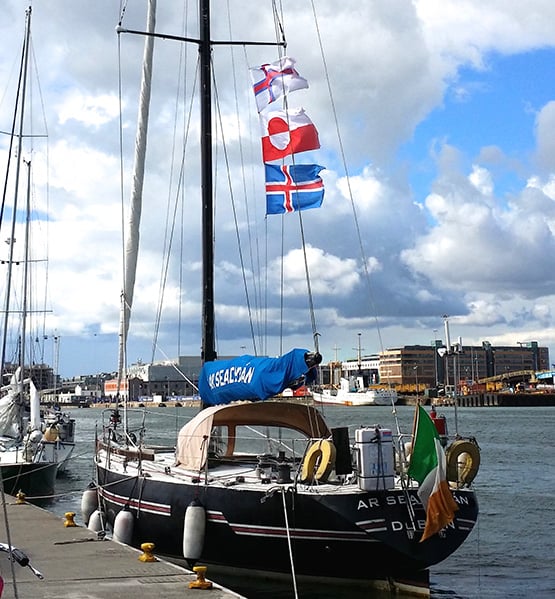
You collect very few courtesy ensigns in the frozen north. Back at Poolbeg in Dublin after her “North Atlantic Crescent” round Iceland and on to Greenland, Paddy Barry’s Ar Seachran sports the flags of the Faroes, Iceland and Greenland. Ar Seachran is a 1979 alloy-built Frers 45. Photo: Tony Brown
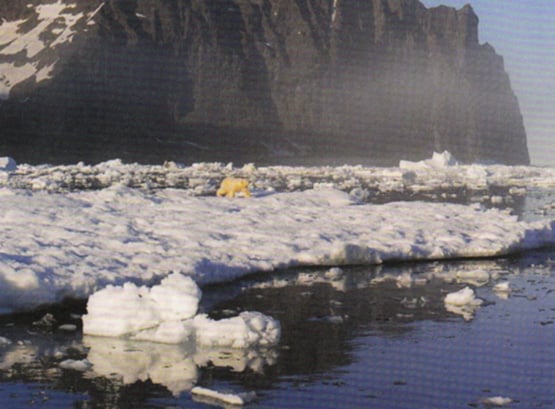
“Definitely the Arctic”. A polar bear spotted from Ar Seachran. Photo: Ronan O Caoimh
Paddy Barry started his epic ocean voyaging many years ago with the Galway Hooker St Patrick, but his cruising boat these days is very different, a classic Frers 45 offshore racer of 1979 vintage. Probably the last thing the Frers team were thinking when they turned out a whole range of these gorgeous performance boats thirty-five years ago was that their aluminium hulls would prove ideal for getting quickly to icy regions, and then coping with sea ice of all shapes and ices once they got there. But not only does Paddy Barry’s Ar Seacrhran do it with aplomb, so too does Jamie Young’s slightly larger sister, the Frers 49 Killary Flyer (ex Hesperia ex Noryema XI) from Connacht, whose later adventures in West Greenland featured recently in a TG4 documentary.
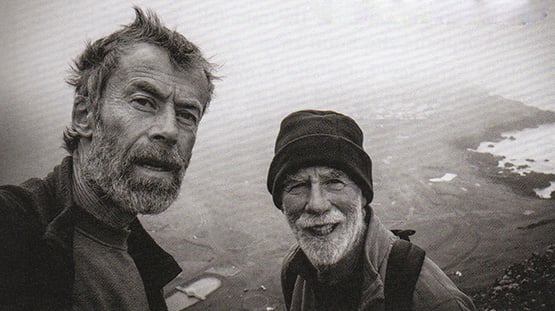
“A grand soft day in Iceland”. Harry Connolly and Paddy Barry setting out to take on mountains in Iceland during their award-winning cruise to Greenland. Photo: Harry Connolly
Pure Magic and Ar Seachran are hefty big boats, but the other ICC voyager rewarded last night by Hilary Keatinge for getting to Arctic waters did his cruise in the Lady Kate, a boat so ordinary you’d scarcely notice her were it not for the fact that she’s kept in exceptionally good trim.
Drive along in summer past the inner harbour at Dungarvan in West Waterford at low water, and you’ll inevitably be distracted by the number of locally-based bilge-keelers sitting serenely upright (more or less) on that famous Dungarvan mud. There amongst them might be the Moody 31 Lady Kate, for Dungarvan is her home port.
But she was away for quite a while last year, as Donal Walsh took her on an extraordinary cruise to the Arctic, going west of the British mainland then on via Orkney and Shetland to Norway whose coast goes on for ever until you reach the Artic Circle where the doughty Donal had a swim, as one does, and looked at a glacier or too, and then sailed home but this this time leaving the British mainland to starboard. A fabulous 3,500 mile eleven week cruise, he very deservedly was awarded the Fingal Cup for a venture the adjudicator reckons to be extra special – as she puts it, “you feel you’re part of the crew, though I don’t think I’d have done the Arctic Circle swim.”
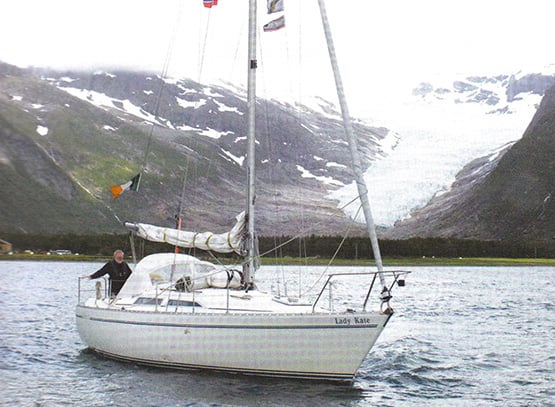
A long way from Dungarvan. Lady Kate with Donal Walsh off the Svartsen Glacier in northern Norway
Indeed, in taking an overview of the placings of the awards, you can reasonable conclude that the adjudicator reckons any civilized person can have enough of ice cruising, as she gives the ICC’s premier trophy, the Faulkner Cup, to a classic Atlantic triangle cruise to the Azores made from Dun Laoghaire by Alan Rountree with his van de Sadt-designed Legend 34 Tallulah, a boat of 1987 vintage which he completed himself (to a very high standard) from a hull made in Dublin by BJ Marine.
Tallulah looks as immaculate as ever, as we all saw at the Cruising Association of Ireland rally in Dublin’s River Liffey in September. And this is something of a special year for Alan Rountree, as completely independently of the Faulkner Cup award, the East Coast ICC members awarded their own area trophy, the Donegan Cup for longterm achievement, to Tallulah’s skipper. As one of those involved in the decision put it, basically he got the Donegan Trophy “for being Alan Rountree – what more can be said?”
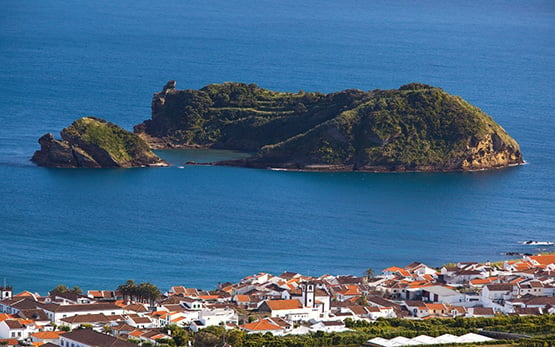
The essence of the Azores. Red roofs maybe, but not an iceberg in sight, and the green is even greener than Ireland. Alan Rountree’s succesful return cruise to the Azores has been awarded the ICC’s premier trophy, the Faulkner Cup.

Tallulah at the CAI Rally in the Liffey last Setpember. She looks as good today as when Alan Rountree completed her from a bare hull nearly thirty years ago. Photo: W M Nixon
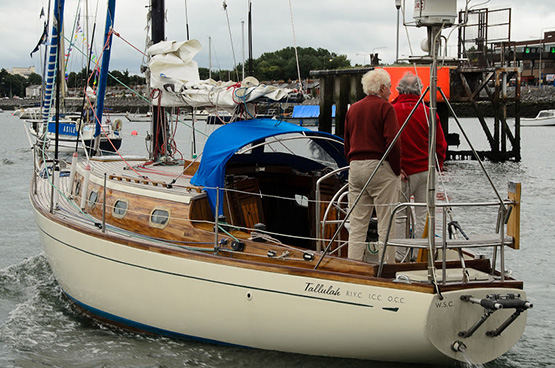
A boat to get you there – and back again. Tallulah takes her departure from the CAI Rally in Dublin. Photo: Aidan Coughlan
Well, it can be said that his Azores cruise was quietly courageous, for although the weather was fine in the islands, the nearer he got to Ireland the more unsettled it became, and he sailed with the recollection of Tallulah being rolled through 360 degrees as she crossed the Continental Shelf in a storm in 1991. But he simply plodded on through calm and storm, the job was done, and Tallulah is the latest recipient of a trophy which embodies the history of modern Irish cruising.
There were many other awards distributed last night, and for those who think that the ICC is all about enormous expensively-equipped boats, let it be recorded that the Marie Trophy for a best cruise in a boat under 30ft long went to Conor O’Byrne of Galway who sailed to the Hebrides with his Sadler 26 Calico Jack, while the Fortnight Cup was taken by a 32-footer, Harry Whelehan’s Jeanneau Sun Odyssey 32 for a fascinating cruise in detail round the Irish Sea, an area in which, the further east you get to coastlines known to very few Irish cruising men, then the bigger the tides become with very demanding challenges in the pilotage stales.
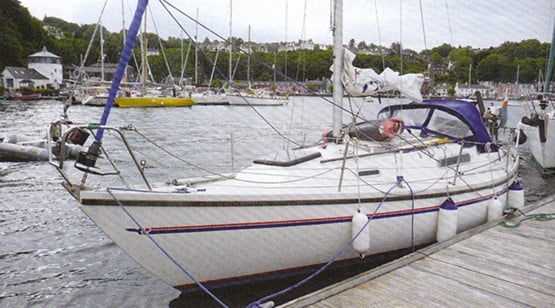
The smallest boat to be awarded a trophy at last night's Irish Cruising Club prize-giving was Conor O’Byrne’s Sadler 26 Calico Jack, seen here in Tobermory during her cruise from Connacht to the Hebrides
As for “expensively equipped”, the Rockabill Trophy for seamanship went to Paul Cooper, former Commodore of Clontarf Yacht & Boat Club and an ICC member for 32 years, who solved a series of very threatening problems with guts and ingenuity aboard someone else’s Spray replica during a 1500 mile voyage in the Caribbean, with very major problems being skillfully solved, as the judge observed, “without a cross word being spoken”.
Not surprisingly in view of the weather Ireland experienced for much of the season, there were no contenders for the Round Ireland cruise trophy, though I suppose you could argue that the return of Pure Magic meant the completion of a round Ireland venture, even if in this case the Emerald Isle becomes no more than a mark of the course.
In fact, with the unsettled weather conditions of recent summers in Ireland , there’s now quite a substantial group of ICC boats based out in Galicia in northwest Spain, where the mood of the coast and the weather “is like Ireland only better”. The ICC Annual gives us a glimpse of the activities of these exiles, and one of the most interesting photos in it is provided by Peter Haden of Ballyvaughan in County Clare, whose 36ft Westerly Seahawk Papageno has been based among the Galician rias for many years now.
Down there, the Irish cruising colony can even do a spot of racing provided it’s against interesting local tradtional boats, and Peter’s photo is of Dermod Lovett of Cork going flat out in his classic Salar 40 Lonehort against one of the local Dorna Xeiteras, which we’re told is the Galician equivalent of a Galway Bay gleoiteog. Whatever, neither boat in the photo is giving an inch.
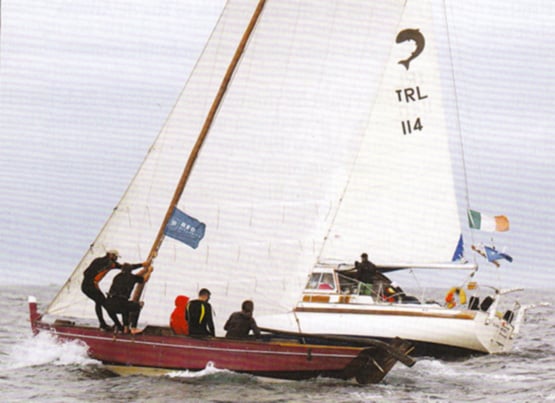
So who never races? Dermod Lovett ICC in competition with his Salar 40 Lonehort against a local traditional Dorna Xeiteira among the rias of northwest Spain. Photo: Peter Haden
Hilary Keatinge’s adjudication is a delight to read in itself, and last night after just about every sailing centre in Ireland was honoured with an ICC award for one of its locally-based members, naturally the crews leapt to the mainbrace and great was the splicing thereof.
But it’s back to porridge this morning in HYC and the serious work of the ISA Cruising Conference, where the range of topics is clearly of great interest, for the Conference was booked out within a very short time of being highlighted on the Afloat.ie website.
It’s during it that we’ll hear more about that intriguing little anchorage which provides our header photo, for although it could well be somewhere on the Algarve in Portugal, or even in the Ionian islands in Greece were it not for the evidence of tide, it is in fact on the Copper Coast of south Waterford, between Dungarvan and Dunmore East, and it’s known as Blind Harbour.
It’s a charming place if you’ve very settled weather, but it’s so small that you’d probably need to moor bow and stern if you were thinking to overnight, but that’s not really recommended anyway. Norman Kean, Editor of the Irish Cruising Club Sailing Directions, had heard about this intriguing little spot from Donal Walsh of Dungarvan (he who has just been awarded the Fingal Cup), and being Norman Kean, he and Geraldine just had to go and experience it for themselves. But it has taken three attempts to have the right conditions as they were sailing by, and it happened in 2015 in a very brief period of settled weather as they headed past in their recently-acquired Warrior 40 Coire Uisge, which has become the new flagship of the ICC’s informal survey flotilla.

The secret cove is to be found on Waterford’s Copper Coast, midway between Dungarvan and Dunmore East. Courtesy ICC
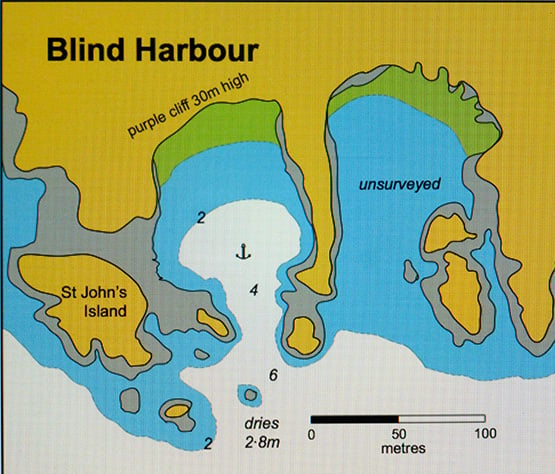
The newly-surveyed Blind Harbour on the Waterford coast as it appears in the latest edition of the ICC’s South & West Coasts Sailing Directions published this month. Courtesy ICC.
They found they’d to eye-ball their way in to this particular Blind Harbour (there are others so-named around the Irish coast) using the echo sounder, as any reliance on electronic chart assistance would have had them on the nearest part of County Waterford, albeit by only a matter of feet. With a similar exercise a couple of years ago, they found that the same thing was the case at the Joyce Sound Pass inside Slyne head in Connemara – rely in the chart plotter, and you’re making the pilotage into “impactive navigation”.
The message is that some parts of charts are still relying on surveys from a very long time ago, and locations of hyper-narrow channels may be a few metres away from where they actually are. On the other hand, electronic anomalies may arise. Whatever the reason, I know that a couple of years ago, in testing the ship’s gallant little chart plotter we headed for the tricky-enough Gillet passage inside the South Briggs at the south side of the entrance to Belfast Lough, and found that it indicated the rocks as shown were a tiny bit further north than we were seeing, which could have caused a but of a bump if we’d continued on our electronic way.
Electronic charts are only one of many topics which will be covered today. We hope to bring a full report next Saturday, for the participants will in turn require a day or two to digest their findings.
Irish Arctic Sailor Among First To Congratulate Guo Chuan on North East Passage World Record
Irish offshore sailor Jarlath Cunnane, the first Irish skipper to transit the northeast passage with Northabout in 2003-2004, has been among the first to congratulate Guo Chuan on his world record in transiting the treacherous 3240nm passage.
“This is a great and fantastic achievement. But it also shows how much the ice is retreating. Guo Chuan and his team were sailing in a mostly ice free waters in areas where – just eleven years ago - we were up against ice which was 5 metres thick”, Cunnane told Afloat.ie
After 13 days of racing on the the North East Passage, Qingdao China, led by Chinese skipper Guo Chuan, finally crossed the finish line on the Bering Strait at 16.48 UTC September 15, 2015. Skipper Guo Chuan and his five crew from Germany, France, and Russia completed the journey. For the very first time in history, a racing trimaran sailed non-stop successfully through the Arctic Ocean Northeast Passage from Murmansk to Bering Straits.
Departing from Murmansk around noon on September 3, Qingdao China crossed the start line at 13.41 UTC and started the attempt to challenge the first non-stop sailing world record across the Arctic Ocean’s North East Passage. The start of the voyage was treacherous as strong winds were expected for the first 3 days.
Because of the weather, Guo Chuan decided to pilot the trimaran to a more southerly route into the Kara Sea. After sailing among growlers and icebergs across the Laptev Sea, the crew experienced the extreme cold and big gusts on the East Siberia Sea. Sunshine welcomed them on the Chukchi Sea and after that, it took them only over a day to reach the finish line between the Cape Dezhnev and the Big Diomede Island on the Bering Strait.
As soon as they crossed the finish line, the crew jumped for joy and pride. For celebration, they prepared a special ceremony. German crew Boris took out a white board and Guo Chuan wrote the historic moment onto it, “Arctic Ocean, Northeast passage, World Record, 15 September, 2015.”
chuan finish
The Chinese skipper was so excited that he could not hold back his emotions. “I’m so on the top of the world. It’s such an unbelievable moment. Even two months ago, I wouldn’t have imagined I could have a moment like this. It is a moment that could only happen in a dream,” he exclaimed.
Looking back the 13 day voyage, Guo said, “I feel very proud of myself and my crew. It is a challenging and tough journey, especially as we were surrounded by ice and gusts under the extreme cold weather. The boat was bumping like roller-coaster sometimes and seemed totally out of control. For several times, when we were in a very difficult situation, I wondered if we could continue. But thanks to our determination and brave and excellent crew, we overcame the difficult times together and finally made it.”
As a Chinese skipper leading five international crew, Guo said it was not only a special experience for him as a leader but also carried the symbolic significance of “peace and sport”. “This is an international team, our crew are from China, France, Germany, and Russia. Obviously we come from different cultures, but we still work together and made a great voyage successful. As the only Chinese champion for ‘Peace and Sport’, I want to spread the peace message to more people. Now in the world, there are still nations at war, but we want to show that people from diverse backgrounds can do things together,” Chuan said.
chuan peace
Guo Chuan received the congratulations from “Peace and Sport” the moment after crossing the finish line. “No matter the difficulty of the journey through the wind and ice, you and your crew faced it all, showing commitment to your objectives, your passion and the core values of sport. It is a true example for the world and I am very proud to count you among Peace and Sport’s Champions for Peace.”, JoelBouzou, chairman of Peace and Sport wrote in the congratulations letter to GuoChuan.
This is another exceptional achievement for Guo Chuan, who is the iconic face of Chinese offshore sailing. Lingling Liu, Managing Director of Guo Chuan Racing, has been receiving congratulations from the world’s sailing community. “This is a project led by a Chinese skipper and managed by Chinese professional, and supported by experts from all over the world. We are so proud that we made it!” Liu said.
Weather expert Christian Dumard said, “It was like the first race around the world or the first person to climb to the top of the Everest.”
Yves Le Blévec, skipper of the Ultime trimaran, Actual said, “I’m watching Guo Chuan’s challenge closely. Making your way through such an extreme zone on this size of trimaran is clearly a huge challenge. Guo Chuan and his crew did a great job. ”
Kito de Pavant, skipper of the 60-footIMOCA Bastide Otio and an expert in multihull racing said, “This is a very interesting course and the challenge is bound to be tricky. But Guo Chuan is sailing perfectly reasonably. His performance is opening up new routes. Other sailors may well want to follow in his footsteps. We can even imagine that one day races will pass through there. It’s something we need to keep an eye on.”
Benoit Cabaret, designer of the Qingdao China trimaran (former IDEC) said: “As the boat’s designer, I was surprised to learn that an Ultime trimaran was going to attempt this tricky passage. New challenges are not that common today, which makes Guo Chuan and his crew’s accomplishment all the more remarkable.”
The Arctic Ocean Northeast passage non-stop sailing world record is the second world record Guo Chuan has achieved. In2013, he set the world record of solo non-stop circumnavigation in a Class 40 monohull. And maybe he has made one more.
At 14h00 UTC 8 September, Qingdao China touched the northernmost water that no other unpowered racing boat had ever reached in the past. She sailed at 78°33’25 North, only 1271 km (686 miles) from the North Pole. It is the first time that a racing boat has sailed so far north.
During the whole voyage, Qingdao China reached maximum instant speed of 37 knots on September 4, and covered 466 miles during one 24 hour stretch during the Arctic Ocean World Record Challenge between the 4th September at 11h04 and the 5th September at 11h04 with an average speed 19.43 knots.
The result of Qingdao China’s voyage will be delivered to WSSRC for validation and the world record announcement will be officially confirmed at a later date.
A weekly video series was produced by award-winning director Stewart Binns to follow along. Here is the series timeline:
August 18: Departure footage from Brittany, France
August 25: Arrival into Kirkenes, Norway
August 31: The Challenge Awaits: Arrival into Murmansk
September 4: Departure from Murmansk, Russia
September 10: Arctic Ocean halfway update
September 17/18: Northeast Passage finish
Guo Chuan’s 'Qingdao China' Trimaran Has Less Than 1,000 Nautical Miles To Go
After eight days sailing on the treacherous waters of the Arctic Ocean, skipper Guo Chuan has less than 1000nm remaining onboard his 97-foot trimaran Qingdao China in order to set the World Record for a non-stop sail of the Northeast Passage from Europe to the Pacific via the Bering Strait.
Global media coverage has started to pick up on the impressive challenge undertaken by Guo and his international crew of four sailors and one media crew member from France, Germany and Russia.
German news stories have been extensive with some of the country’s largest national papers including Die Welt, Tagesspiegel and Frankfurter Allgemeine Zeitung highlighting the drama of the Arctic Ocean World Record Challenge and the adventure of the team’s German sailor Boris Herrmann. France's L'Equipe newspaper has been following along.
Lingling Liu, Managing Director of Guo Chuan Racing has been receiving dozens of media inquiries from around the world. "Before that, all the French thought Guo was crazy. Guo is really doing something exceptional. Everybody thought it was impossible and suddenly people realize that it is possible and that somebody is doing it.”
Weather expert Christian Dumard of France added: “It was like the first race around the world or the first person to climb at the top of the Everest.”
Departing from Murmansk around noon on September 3, Qingdao China crossed the start line at 13.41 UTC and started the attempt to set the first non-stop sailing world record across the Arctic Ocean’s Northeast Passage.
With strong winds during the first three days, Guo Chuan decided to pilot the trimaran to a more southerly route then originally planned. Qingdao China reached maximum speed of 37 knots on September 4, and covered 466 miles during one 24-hour stretch of the Arctic Ocean World Record Challenge between September 4 at 11h04 and September 5 at 11h04 with an average speed of 19.43 knots.
Guo and his crew have become accustomed to seeing icebergs, especially when they sailed above the 75 degrees north latitude. They remain very careful and vigilant about this danger.
Benoit Cabaret, designer of the boat has been following Guo’s journey closely, “I am very happy to see that they went through the most difficult part of the course without any problem.”
And Guo Chuan is philosophical about the scene he has witnessed: "In view of
sailing, I do not want to see any Arctic ice as it would be dangerous for the fragile hull. However, it is really sad to see such disappearance of icebergs caused by global warming. Though it makes the route navigable, I would like to see more ice deep in my heart."
Qingdao China has now sailed through the Laptev Sea and will soon enter the East Siberian Sea and the Chukchi Sea, she will head south until reaching the finish line at Bering Strait.
Weather expert Dumard added that from the most recent weather forecast analysis, Qingdao China is expected to complete the voyage on September 14.
A world record is waiting!
Chinese Skipper Guo Chuan Reaches Halfway Point of World Record Attempt
New Photo Exhibition Charts Arctic Circle Adventure
#Arctic - The visual fruits of last summer's epic North Of Disko expedition from Galway Bay to Greenland and the Arctic will be on show at a new exhibition in Dublin.
TheJournal.ie has a sample of some of Daragh Muldowney's photographs from the voyage that comprise the new gallery show at The Copper House, off Synge Street in Portobello, from this Wednesday 1 October till Friday 7 November.
Muldowney's stunning shots take in all the majestic sights he and his fellow adventurers were treated to on their 1,600-mile voyage across the North Atlantic to Aasiaat in western Greenland, travelling north along the Baffin Bay coast to Upernavik, inside the Arctic Circle.
As previously reported on Afloat.ie, from there a team of four set out on an unsupported sea kayak expedition to explore the region's fjords and ice fields, followed on land by a team of climbers tackling some of the area's frozen peaks.
Also launching at Muldownney's exhibition this week is his book of photographs from the voyage, Out of Thin Air.
TheJournal.ie has more on the story HERE.
Canadian Shipwreck Discovery Solves 170-Year-Old Mystery
#Shipwreck - "One of Canada's greatest mysteries has been solved," said that country's Prime Minister Stephen Harper earlier this month upon news that the wreck of one of two ships famously lost in a mid-19th-century Arctic expedition has likely been located.
National Geographic has details of the rediscovery of the remains of either the HMS Erebus and HMS Terror, both of which disappeared in 1846 during an ill-fated expedition led by Sir John Franklin to map the Northwest Passage.
Sonar images captured by an ROV off King William Island in the northern Canadian province of Nunavut show the mostly intact hull of a ship – and according to maritime historian James Delgado, "there is no doubt" that it represents that final resting place of one of the lost vessels.
What's more, the ship's largely preserved condition means it could prove an invaluable "time capsule" to learn more about the people who embarked on that voyage some 170 years ago.
National Geographic has much more on the story HERE.
New Lease Of Life In Mayo For Unusual Arctic Visitor
#ArcticBuoy - An extraordinary visitor to Ireland's shores will be the subject of a new exhibition in Belmullet, Co Mayo next week.
As The Irish Times reports, Fergus Sweeney was on the shoreline at Blacksod in north Mayo last autumn when he spotted an unusual buoy floating in the water.
It turned out to be attached to an ice-tethered profiler, or ITP, that had been deployed three years before by American researchers on an ice floe in the Arctic Ocean - some 15,000 miles away.
The device was one of 60 deployed in an network measuring climate change, some of which have been lost, but none had been previously discovered further south than the Outer Hebrides.
But while its working life ended in 2012 thanks to water damage, the device will have a new lease of life thanks to Sweeney and a grow of local Transition Year students who have put together an exhibition tracing the buoy's voyage across the oceans.
The Irish Times has more on the story HERE.
#arctic – Cork Institute of Technology, through its Nimbus Centre and the Halpin Centre for Research & Innovation at the National Maritime College of Ireland, is to become a global leader in training small-craft mariners who work in extremely challenging Arctic conditions.
As the Arctic region continues to open up to shipping, cruise, fishing exploration and leisure boat activities, there is now an urgent need for safety and emergency response training for mariners. While regulated training is widely available for large vessel crews, this is not the situation for small craft mariners who find it generally difficult to access Arctic-specific training.
The Small Craft Emergency Response and Survival Training for Arctic Conditions or SMACS Project aims to fill this gap by developing a safety and emergency response training programme specifically focused on the needs of small craft mariners. Uptake of this training programme will make the Arctic a safer location for small craft maritime activity.
CIT is leading the SMACs project along with Chalmers University in Sweden and MSSTC in Iceland. The other partners are frontline Arctic Search and Rescue agencies, SSRS the Swedish maritime search and rescue organisation and NSSR, the Norwegian SAR agency. SMACS also has associated partners in Greenland, Norway, Faeroes and Ireland.
A Memorandum of Understanding has been signed between the NMCI Acting Head of College, Michael Delaney, Associate Head of NMCI, Cdr Dave Barry and Randy Billard, CTO of Virtual Marine Technology, and it represents yet another progression in simulation research and development ensuring that both NMCI and VMT remain at the leading edge.
Mr Delaney said "We are delighted to be working with VMT in the development of new and innovative simulation technologies the use of which continues to place the NMCI at the cutting edge as regards the use of simulation as an education and training tool.
Virtual Marine Technology based in St John's, Newfoundland and Labrador develops small craft simulators for the offshore and defence industries and specialise in harsh environmental conditions simulation. VMT's simulators are internationally certified for small craft training and incorporate advanced ice models that have been rigorously tested by ice experts from the St John's Ocean Technology Cluster.
"We are privileged to have been selected to bring our expertise in ice simulation to such a prestigious maritime development team" said Randy Billard, CTO for VMT. "We believe that Northern Europe, with its similar operational environment, can benefit from the advanced training technologies we have developed in Newfoundland and Labrador."
Simulation will be used as a training tool. Through the Halpin Centre at NMCI and the NIMBUS Centre. The SMACs project will work with VMT to validate the fidelity and performance of a lifeboat and ice environments simulator prototype being developed by VMT. The Halpin Centre at NMCI will also jointly develop with VMT a simulation based training curriculum for operators in emergency evacuation and rescue scenarios. Both the Halpin Centre at NMCI and VMT will jointly publish the results of research undertaken using this simulation technology.
The programme is funded under the EU Northern Periphery Programme (www.northernperiphery.eu ) and supported by the European Regional Development Fund
Irish Sailors Set for Arctic Circle Adventure
Last minute packing, food drying, wiring and boat preparations are being hurried along as the North Of Disko crew prepare to set sail from Galway for Greenland in less than two weeks time. As previously reported on Afloat.ie, the voyage is organised by Killary Adventure Expeditions, 'North of Disko' will see a crew of sailors, kayakers, climbers, a photographer and filmmaker set sail for the northwest coast of Greenland on June 15th.
The crew aim to cover over 1500nm to Aasiaat in Greenland, in about 14 days and then continue north, reaching Upernavik, well inside the Arctic Circle, a week later. From there, a team of four will set out on a 300km unsupported sea kayak, navigating through fjords and ice fields, while the team of three climbers will begin to tackle a series of first ascents, as they follow the kayakers south.
Adding a further dimension to the expedition, photographer Daragh Muldowney aims to explore and capture the beauty of this spectacular coastline, with the aim of publishing a book and hosting an exhibition upon return. The entire expedition and its achievements will also be documented through film by one of only two female crew-members, Claire Riordan.
Leading the crew on board the 49ft, ex admirals cup racing yacht the 'Killary Flyer' is Jamie Young, whose previous expeditions include the successful Irish Cape Horn Sea Kayak Expedition in 1989, the Guinea Bissau Sea Kayak Expedition in 1992, and the 'South Aris' expedition, which attempted to re-enact Shackleton's epic boat trip from Elephant Island to South Georgia, in 1997.
The crew also includes four young twenty-somethings embarking on the adventure of a lifetime as well as seasoned kayakers Ali Donald, Kevin O'Callaghan and climber Collin Gibbon.
Further information on the expedition, crew and updates on preparations can be found at www.northofdisko.com




























